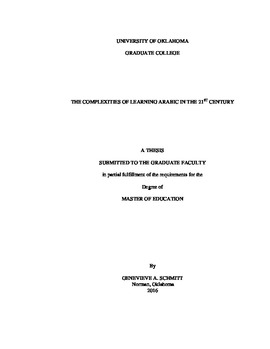| dc.contributor.advisor | Baines, Lawrence | |
| dc.contributor.author | Schmitt, Genevieve | |
| dc.date.accessioned | 2016-12-19T17:35:57Z | |
| dc.date.available | 2016-12-19T17:35:57Z | |
| dc.date.issued | 2016-12-16 | |
| dc.identifier.uri | https://hdl.handle.net/11244/47095 | |
| dc.description.abstract | Of four levels of difficulty and of hundreds of languages spoken worldwide, Arabic is considered a category 4, which means it is among the most difficult languages to learn. While Modern Standard Arabic (Fusha) is most frequently taught, no one really speaks Modern Standard Arabic (MSA), but rather one of the many regional dialects (Amiyya). Due to its linguistic complexities, educators are divided on how to teach Arabic in domestic language programs in the United States and in study abroad programs in the Arab world. An investigation into programs catering to Americans learning Arabic as a foreign language revealed a heavy emphasis on reading and writing in MSA, but scant attention given to speaking and listening in the real language of the people--dialects. Recommendations are made for improving pedagogy and materials so that students can gain genuine communicative competence in Arabic, which means not only understanding MSA, but also speaking and listening in an appropriate dialect. | en_US |
| dc.language | en_US | en_US |
| dc.subject | Education, Bilingual and Multicultural. | en_US |
| dc.title | The Complexities of Learning Arabic in the 21st Century | en_US |
| dc.contributor.committeeMember | Al-Masri, Mohammad | |
| dc.contributor.committeeMember | Hill, Crag | |
| dc.date.manuscript | 2016-12-08 | |
| dc.thesis.degree | Master of Education | en_US |
| ou.group | Jeannine Rainbolt College of Education::Department of Instructional Leadership and Academic Curriculum | en_US |
| shareok.nativefileaccess | restricted | en_US |
